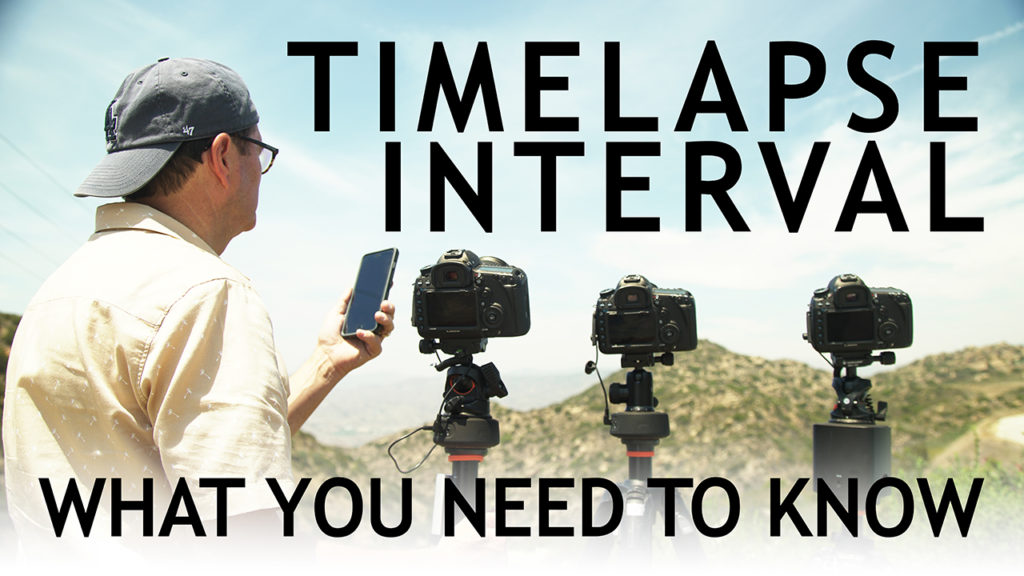Check out my affiliate links at Amazon and B&H Photo Video to purchase your time-lapse equipment from Syrp.
Hi, this is Jay P. Morgan. Today on The Slanted Lens we’re out here on location, photographing clouds to test how interval controls speed when you’re doing time-lapse. We’re also going to compare interval to footage that’s been sped up. Let’s get started and see what we can do.
First, I want to show how interval is going to control the speed of the clouds. I’ve got three cameras set up: one at 2 second intervals, one at 4 seconds, and one at 8 seconds. We’re using all of our Syrp equipment today. We’ve got two Genie Minis and a Genie doing our time-lapse for us.
The clouds move at a slow pace, so at a 2 second interval, they’re not moving very far in between exposures.
When you change to 4 seconds, they’re moving further between exposures.
And at 8 seconds, they’re moving a lot more between the exposures, so now the clouds speed up.
They move faster, but they also move further in between each exposure. The longer the interval, the faster the clouds are going to move.
If I need 240 frames for 10 seconds of time-lapse, it only takes me about 8 minutes to do a 2 second interval, but it’s going to take me 16 minutes to do a 4 second interval. It will take me 32 minutes to get an 8 second interval. The reality is that for the first eight minute segment, I’m seeing the same clouds. In the second eight minutes I only seeing it on two cameras, and in the last eight minutes I only seeing it on the 8 second interval camera. You need more clouds. It keeps rolling over, but it does speed them up. To get 240 frames, or 10 seconds of time-lapse, it’s going to take us a lot longer with an 8 second interval than at 4 seconds. That’s just the way it is.
When it comes time to edit the time-lapse together, we can look at this footage side by side. We can see that the 4 seconds compared to 2 second intervals sped up 100% looks really similar. It’s pretty hard to tell them apart, so we could go either way with those. When we look at the 8 second intervals compared to the 2 sped up 200%, I think the 8 seconds looks smoother. The 2 second interval sped up 200% is a little more choppy, so I’d probably go with the eight second interval – that’s just my personal choice – but looking at the two of them together, it’s pretty hard to tell. They’re very similar.
The reality is, clouds move relatively quickly, so you’re going to need a fairly short interval to get the information you need. If you’re shooting mushrooms, or something growing, obviously you’re going to need a very long interval. I like a shorter intervals because it gives me a lot of data to work with. If I shoot every two seconds, but like the look of the footage at four seconds better, I can throw all the odd numbers out on a timeline, renumber in Bridge, and I’ve got now a four second interval. I can throw all the odd numbers out again, renumber them in Bridge again, and I now have an eight second interval. More data gives me more options. I can speed it up. I can throw them out and create new timelines, but I have all the information.
Personally, I love two second intervals. I use that most of the time. If the clouds are moving super fast then I may go to a one second interval. Or, if the data’s really slow, and I’m looking at those clouds thinking, “They are so far away, and they’re moving so slow,” then I’ll need an eight second interval before I’m going to get anything. There’s no reason for me to get all that data because I’m never going to use it.
This process becomes the art of time-lapse. You have to make some decisions. You’ve got to make decisions about shutter speed. Shutter speed won’t affect cloud movement, not like interval does. They don’t move fast enough for that.
Let’s see some of your time-lapse. Join our Facebook group. Get some time-lapse on there. I love to see what other people are doing, the things that they’re creating. It’s a lot of fun. Keep those cameras rolling, keep on clicking.
Jay P.
P.S. Enter our giveaway to win a case of GaffTac from Rosco or a StarLight Octodome kit from Photoflex. Check it out here.

